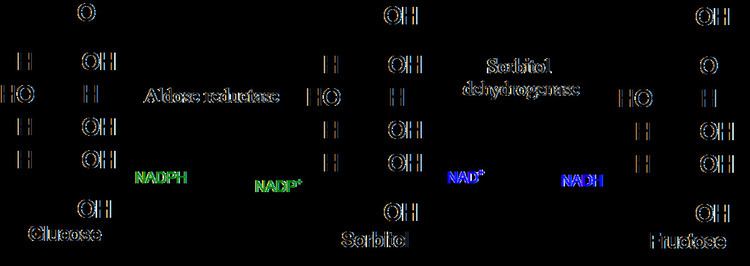 | ||
Also called the sorbitol-aldose reductase pathway, the polyol pathway appears to be implicated in diabetic complications, especially in microvascular damage to the retina, kidney, and nerves.
Contents
Sorbitol cannot cross cell membranes, and, when it accumulates, it produces osmotic stresses on cells by drawing water into the insulin-independent tissues.
Pathway
Cells use glucose for energy. This normally occurs by phosphorylation via the enzyme hexokinase. However, if large amounts of glucose are present (as in diabetes mellitus), hexokinase becomes saturated and the excess glucose enters the polyol pathway when aldose reductase reduces it to sorbitol. This reaction oxidizes NADPH to NADP+. Sorbitol dehydrogenase can then oxidize sorbitol to fructose, which produces NADH from NAD+. Hexokinase can return the molecule to the glycolysis pathway by phosphorylating fructose to form fructose-6-phosphate. However, in uncontrolled diabetics that have high blood glucose - more than the glycolysis pathway can handle - the reaction's mass balance ultimately favors the production of sorbitol.
Activation of the polyol pathway results in a decrease of reduced NADPH and oxidized NAD+; these are necessary cofactors in redox reactions throughout the body, and under normal conditions they are not interchangeable. The decreased concentration of these NADPH leads to decreased synthesis of reduced glutathione, nitric oxide, myo-inositol, and taurine. Myo-inositol is particularly required for the normal function of nerves. Sorbitol may also glycate nitrogens on proteins, such as collagen, and the products of these glycations are referred-to as AGEs - advanced glycation endproducts. AGEs are thought to cause disease in the human body, one effect of which is mediated by RAGE (receptor for advanced glycation endproducts) and the ensuing inflammatory responses induced. They are seen in the hemoglobin A1C tests performed on known diabetics to assess their levels of glucose control.
Pathology
While most cells require the action of insulin for glucose to gain entry into the cell, the cells of the retina, kidney, and nervous tissues are insulin-independent, so glucose moves freely across the cell membrane, regardless of the action of insulin. The cells will use glucose for energy as normal, and any glucose not used for energy will enter the polyol pathway. When blood glucose is normal (about 100 mg/dl or 5.5 mmol/l), this interchange causes no problems, as aldose reductase has a low affinity for glucose at normal concentrations.
In a hyperglycemic state, the affinity of aldose reductase for glucose rises, causing much sorbitol to accumulate, and using much more NADPH, leaving less NADPH for other processes of cellular metabolism. This change of affinity is what is meant by activation of the pathway. The amount of sorbitol that accumulates, however, may not be sufficient to cause osmotic influx of water.
NADPH acts to promote nitric oxide and glutathione production, and its deficiency will cause glutathione deficiency as well. A glutathione deficiency, congenital or acquired, can lead to hemolysis caused by oxidative stress. Nitric oxide is one of the important vasodilators in blood vessels. Therefore, NADPH prevents reactive oxygen species from accumulating and damaging cells.
Excessive activation of the polyol pathway increases intracellular and extracellular sorbitol concentrations, increased concentrations of reactive oxygen species, and decreased concentrations of nitric oxide and glutathione. Each of these imbalances can damage cells; in diabetes there are several acting together. It has not been conclusively determined that activating the polyol pathway damages microvasculature.
